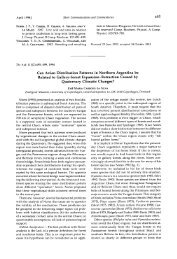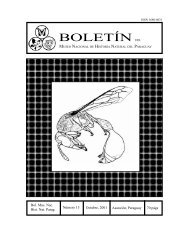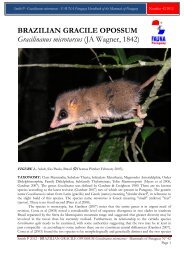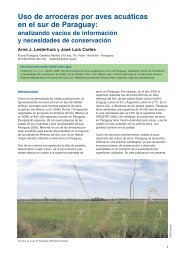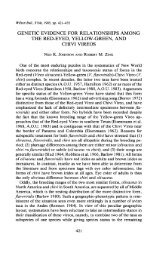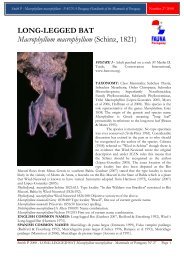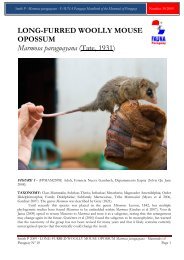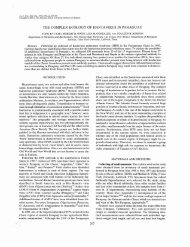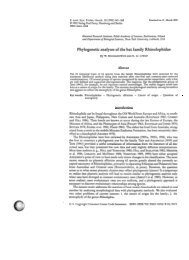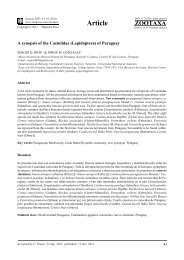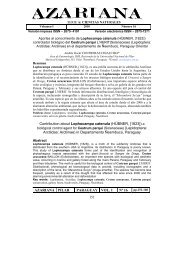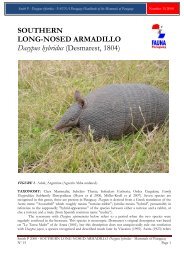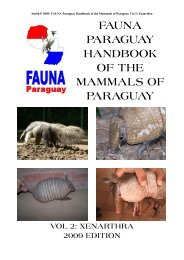Smith P 2007 - FAUNA Paraguay Handbook of the
Smith P 2007 - FAUNA Paraguay Handbook of the
Smith P 2007 - FAUNA Paraguay Handbook of the
Create successful ePaper yourself
Turn your PDF publications into a flip-book with our unique Google optimized e-Paper software.
<strong>Smith</strong> P - Euphractus sexcinctus - <strong>FAUNA</strong> <strong>Paraguay</strong> <strong>Handbook</strong> <strong>of</strong> <strong>the</strong> Mammals <strong>of</strong> <strong>Paraguay</strong> Number 5 <strong>2007</strong><br />
SIX-BANDED ARMADILLO<br />
Euphractus sexcinctus Linnaeus, 1758<br />
FIGURE 1 - Adult, Bolivia (Paul <strong>Smith</strong> April 2009).<br />
TAXONOMY: Class Mammalia; Subclass Theria; Infraclass Eu<strong>the</strong>ria; Order Cingulata; Family<br />
Dasypodidae; Subfamily Euphractinae (Myers et al 2006, Möller-Krull et al <strong>2007</strong>). The genus Euphractus<br />
was defined by Wagler in 1830 and contains a single species. The genus name Euphractus was taken from<br />
<strong>the</strong> Greek meaning "true or good shell" and <strong>the</strong> species name sexcinctus means "six bands". Five subspecies<br />
were tentatively recognised by Gardner (<strong>2007</strong>), two <strong>of</strong> which are present in <strong>Paraguay</strong> - Euphractus sexcinctus<br />
flavimanus (Desmarest 1804) in <strong>the</strong> east and E.s.boliviae in <strong>the</strong> Chaco (O.Thomas 1907). Desmarest´s<br />
description <strong>of</strong> <strong>the</strong> subspecies E.s.flavimanus was based on de Azara´s (1801) "Le Tatou Poyou" and<br />
"L´´Encoubert" <strong>of</strong> Buffon (1763). Synonyms adapted from Gardner (<strong>2007</strong>):<br />
Dasypus sexcinctus Linnaeus 1758:51. Type locality "America Meridionali" restricted to Pará, Brazil by<br />
O.Thomas (1907).<br />
lor[icatus]. flavimanus Desmarest 1804:28. Type locality “<strong>Paraguay</strong>”, based on de Azara (1801) and Buffon<br />
(1763).<br />
<strong>Smith</strong> P <strong>2007</strong> - SIX-BANDED ARMADILLO Euphractus sexcinctus - Mammals <strong>of</strong> <strong>Paraguay</strong> Nº 5<br />
Page 1
<strong>Smith</strong> P - Euphractus sexcinctus - <strong>FAUNA</strong> <strong>Paraguay</strong> <strong>Handbook</strong> <strong>of</strong> <strong>the</strong> Mammals <strong>of</strong> <strong>Paraguay</strong> Number 5 <strong>2007</strong><br />
Dasypus flavipes G.Fischer 1814:122. Type locality “Paráguay”.<br />
Dasypus gilvipes Illiger 1815:108. Nomen nudum.<br />
Das[ypus]. gilvipes Lichtenstein 1818:215. Renaming <strong>of</strong> Dasypus gilvipes Illiger (1815).<br />
T[atus]. gilvipes Olfers 1818:220. Type locality “<strong>Paraguay</strong>, Brasilien, Guiana”<br />
Dasypus pilosus Olfers 1818:220. Nomen nudum.<br />
Dasypus encoubert Desmarest 1822:370. Type locality “Le <strong>Paraguay</strong>”.<br />
Tatus sexcinctus Schinz 1824:pl.113. Name combination.<br />
D[asypus]. setosus Wied-Neuwied 1826:520. Type locality “in den Grossen Campos Geraes und den Angrän<br />
zenden Gegenden des Sertong” restricted to Bahía, Brazil by Ávila-Pires (1965).<br />
Euphractus musetlinus Fitzinger 1871:259. In part. Type locality “Sud-und-Mittel-Amerika”.<br />
Scleropleura bruneti Milne-Edwards 1872:1. Type locality “San Antonio … Ceará”, Brazil based on deformed<br />
specimen.<br />
[Dasypus (Dasypus)] sexcinctus Trouessart 1898:1145. Name combination.<br />
[Scleropleura] Bruneti Trouessart 1898:1141. Name combination.<br />
[Dasypus] poyú Larrañaga 1923:243. Type locality implied as Uruguay. Based on Dasypus sexcinctus Gmelin<br />
(1788) (=Dasypus sexcinctus Linnaeus 1758) and de Azara (1802).<br />
Euphrachtus sexcictus Vizcaino et al 1999: 311. Incorrect spelling.<br />
Euphractes sexcictus Nava et al <strong>2007</strong>: 260. Incorrect spelling.<br />
ENGLISH COMMON NAMES: Six-banded Armadillo (Wilson & Cole 2000, Gardner <strong>2007</strong>), Yellow<br />
Armadillo (Parera 2002), White-bristled Hairy Armadillo (Long 2003), Pig Armadillo (Merritt 2008).<br />
SPANISH COMMON NAMES: Armadillo de seis bandas (Neris et al 2002), Armadillo amarillo<br />
(Emmons 1999), Peludo (Emmons 1999), Gualacate (Parera 2002), Peji (Cuéllar & Noss 2004),<br />
Quirquincho de seis bandas (Anderson 1997), Peji grande (Anderson 1997).<br />
GUARANÍ COMMON NAMES: Tatu poju M (Villalba & Yanosky 2000), Poju AP (Villalba &<br />
Yanosky 2000), Krypurá Ac (Villalba & Yanosky 2000), Kry´y pura Ac (Esquivel 2001), Tatuguasu<br />
(Cuéllar & Noss 2004), Gatodejai Ay (Cuéllar & Noss 2004), Tatú poyú (Parera 2002), Tatú-podyu<br />
(Emmons 1999). "Poju" and its variations which feature in <strong>the</strong> Guaraní names refers to <strong>the</strong> needle-like<br />
claws <strong>of</strong> <strong>the</strong> forefeet.<br />
DESCRIPTION: Predominately yellowish to reddish-brown in armour colour (usually yellowish), darker<br />
and somewhat blackish-brown on skin. The head plate is triangular with a straight posterior margin,<br />
coming to a blunt point just before <strong>the</strong> nose and is distinctly flattened on <strong>the</strong> upper part. It is relatively<br />
narrow, <strong>the</strong> width about 70-80% <strong>of</strong> its length. It extends as a spur behind <strong>the</strong> eye and <strong>the</strong>re may be traces<br />
<strong>of</strong> scales in a semi-circle below <strong>the</strong> eye. Scales <strong>of</strong> <strong>the</strong> head plate are large and arranged in a well-defined<br />
pattern. Ears are medium-length, extending backwards to <strong>the</strong> second or third line <strong>of</strong> <strong>the</strong> scapular plate.<br />
They are well-separated by a distance greater than <strong>the</strong> ear-length across <strong>the</strong> top <strong>of</strong> <strong>the</strong> head. The carapace<br />
consists <strong>of</strong> two fixed plates, <strong>the</strong> scapular and pelvic plates, with 6 to 8 movable bands separating <strong>the</strong>m<br />
(typically 6 and rarely 8). There is a single "nuchal" band between <strong>the</strong> head and scapular <strong>the</strong> plate. A sparse<br />
covering <strong>of</strong> long, stiff yellowish-tan hairs sprout from <strong>the</strong> skin between <strong>the</strong> bands. The tail is cylindrical<br />
and well-armoured with 2 to 4 bands <strong>of</strong> scales at <strong>the</strong> base. Two to four holes in <strong>the</strong> plates above <strong>the</strong> tail<br />
base are glandular openings responsible for <strong>the</strong> animals distinctive odour - this character is found only in<br />
Euphractus and Chaetophractus. The forefoot possesses five toes with robust claws, <strong>the</strong> third <strong>of</strong> which is <strong>the</strong><br />
longest. Females have two pectoral nipples. Body temperature is 34ºC.<br />
SKELETAL CHARACTERISTICS: Broad and relatively long rostrum. Interorbital with a marked<br />
postorbital constriction. Brain case with obvious lateral markings, somewhat squarish and flattened.<br />
Zygomatic arch slender and elongate. Jugal never twice as high as <strong>the</strong> overlying anterior edge <strong>of</strong> <strong>the</strong><br />
squamosal. Tympanic bulla present. External auditory meatus is ossified. Condylonasal Length: 114.5mm<br />
(109-125.5mm); Zygomatic Width: 68.6mm (61.7-75.4mm). (Diaz & Barquez 2002, Redford & Wetzel 1985).<br />
Skull illustration based on Chebez (2001) and <strong>Smith</strong> & Redford (1990).<br />
Vizcaino et al (1999) give <strong>the</strong> following ulnar dimensions (n=14): Ulnar Length 70.3mm (+/-4.3);<br />
Olecranon Length 27.9mm (+/-4.0). The trend towards fossoriality is correlated with relative development<br />
<strong>of</strong> <strong>the</strong> olecranon process, and <strong>the</strong> ratio <strong>of</strong> <strong>the</strong> ulnar length to olecranon length is <strong>the</strong> Index <strong>of</strong> Fossorial<br />
<strong>Smith</strong> P <strong>2007</strong> - SIX-BANDED ARMADILLO Euphractus sexcinctus - Mammals <strong>of</strong> <strong>Paraguay</strong> Nº 5<br />
Page 2
<strong>Smith</strong> P - Euphractus sexcinctus - <strong>FAUNA</strong> <strong>Paraguay</strong> <strong>Handbook</strong> <strong>of</strong> <strong>the</strong> Mammals <strong>of</strong> <strong>Paraguay</strong> Number 5 <strong>2007</strong><br />
Ability. An IFE above 0.70 is considered indicative <strong>of</strong> a highly fossorial species and one below 0.55 <strong>of</strong> a<br />
cursorial species. This species has an IFE <strong>of</strong> 0.66 (+/-0.07).<br />
The ribs do not imbricate. Rib expansion is more symmetrical than in Dasypus, involving both<br />
anterior and posterior margins <strong>of</strong> <strong>the</strong> rib, and thus resembles <strong>the</strong> myrmecophagid pattern. (Jenkins 1970).<br />
DENTAL CHARACTERISTICS: Armadillos lack true teeth, but possess a series <strong>of</strong> "molariform" teeth<br />
that do not follow <strong>the</strong> standard mammal dental formula. They are particularly robust in this species. 9-<br />
10/10 = 38-40. First molariform located in <strong>the</strong> premaxillary as in Chaetophractus.<br />
Green (2009) looked for a link between <strong>the</strong> orthodentine microwear <strong>of</strong> this species and its diet, but<br />
found considerable intertooth variation, possibly related to <strong>the</strong> uneven distribution <strong>of</strong> bite force on <strong>the</strong><br />
dentition <strong>of</strong> long-faced animals, though food texture and intraspecific variation likely also play a role.<br />
GENETIC CHARACTERISTICS: 2n=58, FN=102. (Gardner <strong>2007</strong>). Redi et al (2005) gives <strong>the</strong><br />
genome size as 4.16pg (+/-0.41) or 4068 Mbp.<br />
TRACKS AND SIGNS: The slightly rocking gait <strong>of</strong> this species leads to a distinctive print pattern in<br />
which <strong>the</strong> steps are almost perfectly aligned but <strong>the</strong> feet are slightly inward pointing towards <strong>the</strong> medial<br />
<strong>Smith</strong> P <strong>2007</strong> - SIX-BANDED ARMADILLO Euphractus sexcinctus - Mammals <strong>of</strong> <strong>Paraguay</strong> Nº 5<br />
Page 3
<strong>Smith</strong> P - Euphractus sexcinctus - <strong>FAUNA</strong> <strong>Paraguay</strong> <strong>Handbook</strong> <strong>of</strong> <strong>the</strong> Mammals <strong>of</strong> <strong>Paraguay</strong> Number 5 <strong>2007</strong><br />
line. The tail is carried clear <strong>of</strong> <strong>the</strong> floor and does not usually leave an impression in <strong>the</strong> substrate. Despite<br />
<strong>the</strong> size <strong>of</strong> <strong>the</strong> animal <strong>the</strong> prints are surprisingly small, leaving somewhat rounded impressions, especially<br />
towards <strong>the</strong> tips <strong>of</strong> <strong>the</strong> digits. The hindfoot appears to have just three short digits and is similar in basic<br />
form to <strong>the</strong> forefoot, though slightly larger and with more rounded pads. FP: 2 x 1.7cm HP: 3 x 2.2cm.<br />
PA: 5cm. (Villalba & Yanosky 2000). Faeces typically with an irregular surface, measure 15 (+/-1.5mm) x<br />
20mm (+/-1.3mm) and contain c62% soil and some plant material (18%). They are <strong>of</strong> fragile consistency<br />
and have a strong odour, presumably due to formic acid and decaying plant material. Weight 2.3g (+/-<br />
0.8mm). Typically found near areas <strong>of</strong> excavation and along trails (Anacleto <strong>2007</strong>).<br />
EXTERNAL MEASUREMENTS: The largest <strong>of</strong> <strong>the</strong> "hairy armadillos" in <strong>Paraguay</strong>. TL: 61.64cm<br />
(40.1-95cm); HB: 39.57cm (34.1-49.5cm); TA: 22.02cm (11.9-30cm); FT: 8.35cm (7.5-9.2cm); EA:<br />
3.52cm (2.4-4.7cm); WT: 4.32kg (2-6.5kg). Like o<strong>the</strong>r "hairy armadillos" <strong>the</strong>y store fat and a captive<br />
female individual reached 11kg in weight. WN: 95-115g. (Parera 2002, Nowak 2001, Emmons 1999,<br />
Ceresoli et al 2003, Redford & Eisenberg 1992, Diaz & Barquez 2002, Redford & Wetzel 1985).<br />
Medri et al (2009) give <strong>the</strong> following measurements for individuals captured in Nhecolândia, Mato<br />
Grosso do Sul, during October 2006 to October <strong>2007</strong>. HB: adult males 47.72cm (+/-1.59, n=14), juvenile<br />
males 30cm (+/-0, n=2), adult females 47.90cm (+/-1.62, n=14), subadult female 40cm (+/-0, n=1); TA:<br />
adult males 23.51cm (+/-1.21, n=14), juvenile males 17cm (+/-0, n=2), adult females 23.01cm (+/-1.18,<br />
n=14), subadult female 20cm (+/-0, n=1); Tail Circumference adult males 12.85cm (+/-0.56, n=12),<br />
juvenile males 7.75cm (+/-0.35, n=2), adult females 13.14cm (+/-0.52, n=14), subadult female 10cm (+/-<br />
0, n=1); FT: adult males 8.57cm (+/-0.72, n=12), juvenile males 7cm (+/-0, n=2), adult females 8.75cm<br />
(+/-0.62, n=13), subadult female 7.80cm (+/-0, n=1); Length <strong>of</strong> Forefoot adult males 7.24cm (+/-1.09,<br />
n=12), juvenile males 6.15cm (+/-1.21, n=2), adult females 7.32cm (+/-0.78, n=13), subadult female 7cm<br />
(+/-0, n=1); EA: adult males 4.13cm (+/-0.39, n=12), juvenile males 3.20cm (+/-0, n=2), adult females<br />
3.99cm (+/-0.43, n=13), subadult female 4cm (+/-0, n=1); Ear Width adult males 2.97cm (+/-0.34,<br />
n=12), juvenile males 2.25cm (+/-0.35, n=2), adult females 2.74cm (+/-0.47, n=13), subadult female<br />
2.50cm (+/-0, n=1); Head Length adult males 13.45cm (+/-0.46, n=14), juvenile males 9.80cm (+/-0.28,<br />
n=2), adult females 13.34cm (+/-0.58, n=14), subadult female 12cm (+/-0, n=1); Head Width adult<br />
males 9.26cm (+/-0.84, n=13), juvenile males 7.25cm (+/-0.35, n=2), adult females 9.29cm (+/-0.77,<br />
n=13), subadult female 7.50cm (+/-0, n=1); Circumference <strong>of</strong> Thorax adult males 46.23cm (+/-3.18,<br />
n=13), juvenile males 26.50cm (+/-2.12, n=2), adult females 45.86cm (+/-2.66, n=14), subadult female<br />
7.50cm (+/-0, n=1); Number <strong>of</strong> Movable Bands adult males 6 (n=9) 7 (n=3), juvenile males 6 (n=2),<br />
adult females 6 (n=11) 7 (n=3), subadult female 6 (n=1); WT: adult males 4.38kg (+/-0.60, n=14),<br />
juvenile males 1.10kg (+/-0.07, n=2), adult females 4.45cm (+/-0.64, n=14), subadult female 2.55kg (+/-<br />
0, n=1).<br />
SIMILAR SPECIES: This is a large armadillo, second only in size to Priodontes maximus. Its covering <strong>of</strong><br />
hair on <strong>the</strong> dorsum means that it is most likely to be confused with larger individuals <strong>of</strong> Chaetophractus<br />
villosus, C.vellerosus being considerably smaller and with notably longer ears. The smallest individuals <strong>of</strong><br />
Euphractus are similar in size to <strong>the</strong> largest individuals <strong>of</strong> Chaetophractus villosus. Note however that villosus is<br />
generally darker and more reddish and hairier overall, especially ventrally, with conspicuous tufts <strong>of</strong> hair<br />
on <strong>the</strong> cheeks, legs and throat. Perversely <strong>the</strong> dark brown hairs <strong>of</strong> <strong>the</strong> dorsum <strong>of</strong> C.villosus may be harder<br />
to see against <strong>the</strong> dark carapace than <strong>the</strong> paler, yellowish-tan hairs <strong>of</strong> Euphractus. The number <strong>of</strong> bands is<br />
variable in this species and whilst C.villosus may possess 7 or 8 bands, it never has 6. Ano<strong>the</strong>r useful<br />
character is <strong>the</strong> flattened head <strong>of</strong> this species; C.villosus shows a more rounded forehead and crown in<br />
pr<strong>of</strong>ile. Behind <strong>the</strong> eye <strong>the</strong> head plate descends as a "spur" in Euphractus which may also show traces <strong>of</strong> a<br />
plate below <strong>the</strong> eye, both <strong>the</strong>se features are absent in C.villosus which has a smooth and even edge to <strong>the</strong><br />
plate behind <strong>the</strong> eye. Examination <strong>of</strong> <strong>the</strong> scales on <strong>the</strong> head plate shows a regular pattern <strong>of</strong> large scales in<br />
this species, that <strong>of</strong> C.villosus is a somewhat less-organised melee <strong>of</strong> smaller scales, generally with a wellmarked<br />
posterior "border". Beyond this border C.villosus shows at least two distinct nuchal bands prior to<br />
<strong>the</strong> scapular plate, only one is present in Euphractus. Note also that Chaetophractus armadillos in <strong>Paraguay</strong> are<br />
confined to <strong>the</strong> Chaco and <strong>the</strong> cerrado belt <strong>of</strong> <strong>the</strong> nor<strong>the</strong>rn Orient, whilst this species is less conservative<br />
in its habitat choice.<br />
<strong>Smith</strong> P <strong>2007</strong> - SIX-BANDED ARMADILLO Euphractus sexcinctus - Mammals <strong>of</strong> <strong>Paraguay</strong> Nº 5<br />
Page 4
<strong>Smith</strong> P - Euphractus sexcinctus - <strong>FAUNA</strong> <strong>Paraguay</strong> <strong>Handbook</strong> <strong>of</strong> <strong>the</strong> Mammals <strong>of</strong> <strong>Paraguay</strong> Number 5 <strong>2007</strong><br />
DISTRIBUTION: Widely distributed in eastern and central South<br />
America east <strong>of</strong> <strong>the</strong> Andes and south <strong>of</strong> Amazonia. In Brazil <strong>the</strong><br />
distribution was long considered to be in two disjunct populations, one<br />
isolated one in Pará State with neighbouring Suriname and extreme<br />
sou<strong>the</strong>rn Guyana and a wider area that is contiguous with its distribution<br />
in neighbouring countries fur<strong>the</strong>r south. However this has more recently<br />
been shown to be an artefact <strong>of</strong> sampling and <strong>the</strong>re are now virtually<br />
continuous records from Amapá, Pará, Maranhão, Piauí, Ceará, Rio<br />
Grande do Norte, Paraíba, Pernambuco, Bahia, Tocantins, Goiás, Mato<br />
Grosso, Mato Grosso do Sul, Minas Gerais, Espírito Santo, Rio de<br />
Janeiro, São Paulo and Rio Grande do Sul (Sousa e Silva Junior et al<br />
2001, Sousa e Silva Junior & Nunes 2001, Goncalves de Andrade et al<br />
2006, Lima et al 2009).<br />
In Bolivia <strong>the</strong>re are records from sou<strong>the</strong>rn Departamento Beni,<br />
Santa Cruz and eastern Departamentos Chuquisaca and Tarija (Anderson<br />
1997). In Uruguay it is found throughout <strong>the</strong> country though specimen records are available from<br />
Departamentos Artigas, Tacuarembó, Rio Negro, Durazno, Cerro Largo, Soriano, Treinta y Tres, Florida,<br />
Colonia, San José, Lavalleja y Rocha (Daniel Hernández in litt.). In Argentina it has been recorded from<br />
<strong>the</strong> following Provincias: Misiones, Corrientes, Formosa, Chaco, Salta, Jujuy, Tucumán, nor<strong>the</strong>rn Santa Fé<br />
and Santiago del Estero. The species was introduced into Central Chile, but does not appear to have<br />
become established (Long 2003).<br />
In <strong>Paraguay</strong> <strong>the</strong> species occurs widely in both eastern <strong>Paraguay</strong> (E.s.flavimanus) and <strong>the</strong> Chaco<br />
(E.s.boliviae) and is absent only from extensively forested areas and urban zones. Abba & Vizcaíno (2008)<br />
list 2 specimens from <strong>Paraguay</strong> in <strong>the</strong> Museo Argentino de Ciencia Naturales "Bernadino Rivadavia mostly<br />
without precise locality data (MACN11.24 skull, 1911; MACN45.028 carapace and skull, San Pedro,<br />
Puerto Casado 1944).<br />
E.s.flavimanus is distributed through eastern <strong>Paraguay</strong>, Mato Grosso in Brazil, nor<strong>the</strong>astern<br />
Argentina and Uruguay. E.s.boliviae occupies <strong>the</strong> Gran Chaco <strong>of</strong> Bolivia, western <strong>Paraguay</strong> and nor<strong>the</strong>rn<br />
Argentina. The remaining subspecies are E.s.setosus in sou<strong>the</strong>astern Brazil, E.s.tucumanus in <strong>the</strong> Argentinean<br />
Provincias <strong>of</strong> Tucumán and Catamarca, and E.s.sexcinctus occupying <strong>the</strong> nor<strong>the</strong>rn part <strong>of</strong> <strong>the</strong> range and<br />
sou<strong>the</strong>rn Surinam. The latter intergrades with flavimanus in Mato Grosso and setosus in sou<strong>the</strong>rn Brazil.<br />
E.s.boliviae intergrades with tucumanus in <strong>the</strong> sou<strong>the</strong>rnmost part <strong>of</strong> its range.<br />
HABITAT: Typical <strong>of</strong> open grassy and scrubby habitats, generally in dry areas, but also occurs in gallery<br />
forest in <strong>the</strong> Pantanal area and seasonally-flooded palm savanna in <strong>the</strong> Humid Chaco. In <strong>the</strong> Dry Chaco<br />
<strong>the</strong>y are less common in densely-forested areas, preferring forest edge and scrub. Merritt (2008) describes<br />
<strong>the</strong> habitat in <strong>the</strong> Chaco as open thorn scrub and thorn forest in areas that have not been affected by land<br />
conversion or human activity, but this species is encountered infrequently in disturbed areas <strong>of</strong> te Central<br />
Chaco such as cattle pastures (P.<strong>Smith</strong> pers.obs.).<br />
In <strong>the</strong> cerrado belt <strong>the</strong>y are found in campo limpio, campo sucio and sensu-stricto cerrado but are<br />
less frequent in cerradón - though Bonato et al (2008) reported that in <strong>the</strong> cerrado <strong>of</strong> Brazil <strong>the</strong>y could<br />
find no clear preference between <strong>the</strong> patchwork <strong>of</strong> cerrado habitats and <strong>the</strong> species was equally common<br />
in grassland and forest. In Piauí, Brazil Goncalves de Andrade et al (2006) found this species in caatinga,<br />
mangrove (small pockets <strong>of</strong> secondary forest and salt marsh), clear cut areas with fragments <strong>of</strong> secondary<br />
forest and clear cut areas between urbanization and mangroves.<br />
In Pará Sousa e Silva Junior & Nunes 2001 found <strong>the</strong> species in Amazonian savanna and disturbed<br />
sensu-stricto cerrado with a high density <strong>of</strong> trees and shrubs. In Maranhão Sousa e Silva Junior et al (2001)<br />
found <strong>the</strong> species in several distinct biomes. 1 “Pré-Amazônia Maranhense” (clearings, <strong>the</strong> border <strong>of</strong><br />
primary/secondary forest, and <strong>the</strong> interior <strong>of</strong> <strong>the</strong> unflooded secondary forest). 2 “Zona dos Cocais”<br />
(plantations in primary/secondary forest borders, plantations associated with Orbignya palm clumps,<br />
pasture, copses in different stages <strong>of</strong> regeneration, and secondary forest). 3 Cerrado (border between <strong>the</strong><br />
“cerrado” sensu stricto and gallery forest). A single animal was captured in an area <strong>of</strong> cerradón. Use <strong>of</strong><br />
habitat was apparently generalist and indiscriminate.<br />
<strong>Smith</strong> P <strong>2007</strong> - SIX-BANDED ARMADILLO Euphractus sexcinctus - Mammals <strong>of</strong> <strong>Paraguay</strong> Nº 5<br />
Page 5
<strong>Smith</strong> P - Euphractus sexcinctus - <strong>FAUNA</strong> <strong>Paraguay</strong> <strong>Handbook</strong> <strong>of</strong> <strong>the</strong> Mammals <strong>of</strong> <strong>Paraguay</strong> Number 5 <strong>2007</strong><br />
Anacleto et al (2006) used <strong>the</strong> genetic algorithm program GARP to predict <strong>the</strong> species distribution<br />
in Brazil, with results suggesting this species would occur in all <strong>the</strong> major biomes - Amazonia, Cerrado,<br />
Caatinga, Pampas, Pantanal and Atlantic Forest - making it <strong>the</strong> most habitat generalist species <strong>of</strong> armadillo<br />
to occur in that country.<br />
Habitat choice is apparently unaffected by fire, a study in <strong>the</strong> cerrado <strong>of</strong> Mato Grosso, Brazil<br />
finding that <strong>the</strong>y utilised burnt areas as frequently as <strong>the</strong>y do unburnt areas when foraging (Prada &<br />
Marinho-Filho 2004) - burning is <strong>of</strong> course a natural occurrence in <strong>the</strong> cerrado biome. Apparently less<br />
common at humid forest edge and probably absent from humid forest interior, but <strong>the</strong> expansion <strong>of</strong> <strong>the</strong><br />
agricultural frontier is probably allowing <strong>the</strong>m to colonise new areas. (Parera 2002, Nowak 2001, Emmons<br />
1999, Neris et al 2002, Redford & Eisenberg 1992).<br />
ALIMENTATION: Omnivorous and able to exploit a wide variety <strong>of</strong> foodstuffs from fruits and plant<br />
matter to meat and even carrion. Eyesight is poor and smell is <strong>the</strong> primary method used for locating food.<br />
Six-banded Armadillos take large insects and exploit seasonally plentiful resources such as palm nuts and<br />
bromeliad fruits - at certain times <strong>of</strong> year plant material can compose a significant part <strong>of</strong> <strong>the</strong> diet. Though<br />
generally solitary, numbers may ga<strong>the</strong>r at large carcasses to feed on carrion and maggots (Nowak 1991). In<br />
common with o<strong>the</strong>r members <strong>of</strong> <strong>the</strong> subfamily Euphractinae <strong>the</strong>y are able to store fat and this may be <strong>of</strong><br />
assistance during seasonal food shortages (Redford & Wetzel 1985).<br />
In Mato Grosso, Brazil, a study found <strong>the</strong> diet to consist <strong>of</strong> 90% plant matter, notably palm fruits<br />
(Acrocomia sp), pineapple (Ananas sp.) and figs (Ficus sp.), with <strong>the</strong> remaining 10% made up <strong>of</strong> beetles,<br />
crickets, ants, spiders, larvae, pupae and one amphibian. A study <strong>of</strong> stomachs <strong>of</strong> road kill individuals in São<br />
Paulo, Brazil found plant matter to make up just 33% <strong>of</strong> <strong>the</strong> diet, whereas insects (principally Formicidae<br />
and Scarabaeidae) made up more than 50% <strong>of</strong> <strong>the</strong> samples. Vertebrate remains included a Sigmodontid<br />
rodent, armadillo plates (likely from scavenging), pig skin, a snake and a small bird (Dalponte & Tavares-<br />
Filho 2004).<br />
One female roadkill individual from Goiás, Brazil had four Calomys sp. mice in its stomach, two <strong>of</strong><br />
which were young (Bezerra et al 2001), while in <strong>the</strong> cerrado <strong>of</strong> Brazil Bonato (2002) found Oxymycterus sp.,<br />
Clymomys sp., remains <strong>of</strong> a tanager (Thraupidae) and snakes amongst vertebrate remains. Bezerra et al<br />
(2001) suggested that predation on rodents during <strong>the</strong> dry season in <strong>the</strong> cerrado may be related to <strong>the</strong><br />
scarcity <strong>of</strong> plant matter available at this time <strong>of</strong> year.<br />
Captive individuals have been seen to kill large rats, but <strong>the</strong>ir hunting technique was ineffectual and<br />
<strong>the</strong>y were incapable <strong>of</strong> making a quick, clean kill (Redford & Eisenberg 1992). The flesh is removed by<br />
standing on <strong>the</strong> carcass and ripping <strong>of</strong>f pieces with <strong>the</strong> mouth (Redford & Wetzel 1985). Captive<br />
individuals have also been observed attacking a Grey Brocket Deer fawn Mazama gouazoubira and a Greater<br />
Rhea Rhea americana and attempting to drag <strong>the</strong>m into <strong>the</strong>ir burrow (Dalponte & Tavares-Filho 2004).<br />
Mercolli & Yanosky (2001) reported wild armadillos <strong>of</strong> this species predating Rhea nests in <strong>the</strong><br />
Chaco <strong>of</strong> Argentina, and suggested that <strong>the</strong> animals had burrowed under <strong>the</strong> nest after <strong>the</strong> laying <strong>of</strong> <strong>the</strong><br />
eggs. They recommended that <strong>the</strong> effect <strong>of</strong> nest predation by armadillos be assessed as a threat to <strong>the</strong><br />
conservation <strong>of</strong> Rheas.<br />
REPRODUCTIVE BIOLOGY: Neris et al (2002) note <strong>the</strong> breeding season as "spring and summer" but<br />
that captive individuals have also engaged in breeding activities during autumn. Pregnant females have<br />
been found in central Brazil during September and October, and in Uruguay during January. Bonato et al<br />
(2008) considered breeding to be year round in <strong>the</strong> Brazilian cerrado whilst Cuéllar (in press) states that in<br />
<strong>the</strong> Bolivian Chaco <strong>the</strong>re is a short concentrated breeding season at <strong>the</strong> end <strong>of</strong> <strong>the</strong> dry season with<br />
maximum fecundity in <strong>the</strong> first months <strong>of</strong> <strong>the</strong> wet season. Desbiez (2006) detailed chasing behaviour<br />
involving up to 8 individuals in a straight line and noted that local people in <strong>the</strong> Brazilian Pantanal<br />
consider this to be a form <strong>of</strong> mate competition, with several males chasing a female ready to breed. Such<br />
chases were seen to last over an hour and covering an area <strong>of</strong> no more than one hectare, <strong>the</strong> animals<br />
moving in and out <strong>of</strong> denser vegetation. A female taken in Mato Grosso, Brazil was pregnant with two<br />
well-developed young in July. The gestation period is 60 to 64 days. Captive females have been seen to<br />
construct nests shortly before giving birth and typical litters contain one to three young and may include<br />
both sexes (Redford & Wetzel 1985). Meritt (1976 in Nowak 1991) states that twins frequently consist <strong>of</strong><br />
one male and one female <strong>of</strong>fspring. Newborns are poorly-developed and have a s<strong>of</strong>t carapace. Females<br />
<strong>Smith</strong> P <strong>2007</strong> - SIX-BANDED ARMADILLO Euphractus sexcinctus - Mammals <strong>of</strong> <strong>Paraguay</strong> Nº 5<br />
Page 6
<strong>Smith</strong> P - Euphractus sexcinctus - <strong>FAUNA</strong> <strong>Paraguay</strong> <strong>Handbook</strong> <strong>of</strong> <strong>the</strong> Mammals <strong>of</strong> <strong>Paraguay</strong> Number 5 <strong>2007</strong><br />
disturbed with <strong>the</strong>ir young may try to move or hide <strong>the</strong>m and/or respond aggressively towards <strong>the</strong><br />
intruder. Young displaced from <strong>the</strong> nest are returned by <strong>the</strong> mo<strong>the</strong>r. The eyes open after 22 to 25 days and<br />
by <strong>the</strong> end <strong>of</strong> <strong>the</strong> first month <strong>the</strong>y have quadrupled in weight and are able to take solid food. Sexual<br />
maturity is reached at 9 months in captivity. (Redford & Eisenberg 1992, Parera 2002, Redford & Wetzel<br />
1985).<br />
GENERAL BEHAVIOUR: Solitary and diurnal or nocturnal, tending to be more nocturnal in areas<br />
where human population pressure is higher (Merritt 2008). Bonato et al (2008) reported that <strong>the</strong> species is<br />
nocturnal in <strong>the</strong> Brazilian cerrado, despite <strong>the</strong> lack <strong>of</strong> human predation in <strong>the</strong> area and suggested that this<br />
was because <strong>the</strong> species maintains body temperatures at a low temperature range. They are active, alert<br />
foragers and constantly on <strong>the</strong> move, maintaining a steady trot with a distinctly rocking motion, stopping<br />
occasionally to investigate potential sources <strong>of</strong> food.<br />
No difference in activity levels between seasons was noted by Bonato et al (2008) but <strong>the</strong>re is some<br />
evidence to suggest that activity patterns are closely tied to rainfall and ambient temperature (Brooks 1995,<br />
Parera 2002). Rocha et al (2006) noted a significant difference in <strong>the</strong> abundance indexes <strong>of</strong> this species<br />
between <strong>the</strong> dry season (April to September) 0.50 (+/-0.49) and <strong>the</strong> wet season (October to March) 1.54<br />
(+/-0.61) in Mato Grosso, Brazil in a study based on footprints. They speculated that this may be due to a<br />
greater availability <strong>of</strong> resources during <strong>the</strong> wet season.<br />
This species has a characteristic odour which is released from holes in <strong>the</strong> plates above <strong>the</strong> base <strong>of</strong><br />
<strong>the</strong> tail (Nowak 1991). Their swimming ability has enabled <strong>the</strong>m to colonise <strong>of</strong>fshore islands in Maranhao<br />
State, Brazil (Hass et al 2003).<br />
Home Range Minimum home range in Brazil was found to average 93.3ha (Nowak 1991, Parera<br />
2002). Captive animals mark <strong>the</strong>ir cages with secretions from <strong>the</strong>ir pelvic scent gland and it would seems<br />
likely that burrows were marked by <strong>the</strong> same means in <strong>the</strong> wild state. (Emmons 1999, Redford &<br />
Eisenberg 2002).<br />
Biomass in <strong>the</strong> Brazilian Pantanal was estimated at18.8kg/km 2 about two-thirds <strong>of</strong> <strong>the</strong> overall<br />
armadillo biomass in <strong>the</strong> area (Redford & Wetzel 1985). In Mato Grosso, Brazil, <strong>the</strong> density was estimated<br />
in varying types <strong>of</strong> habitat with <strong>the</strong> following results 0.48/km 2 in cerrado, 2/km 2 in gallery forest, 0.59/km 2<br />
in secondary forest and 2.9/km 2 in deciduous forest (Parera 2002). In <strong>the</strong> Brazilian cerrado <strong>the</strong> density was<br />
calculated at 0.14 individuals/ha (Bonato 2002, Bonato et al 2008) whereas in <strong>the</strong> Bolivian Chaco it was as<br />
low as 0.012 individuals/ha (Cuéllar in press).<br />
Refuges Adept diggers, <strong>the</strong>y scratch <strong>the</strong> earth with <strong>the</strong> forefeet and uses <strong>the</strong> hindfeet to kick it<br />
clear <strong>of</strong> <strong>the</strong> burrow entrance (Nowak 1991). Caves typically have a single semi-circular entrance with <strong>the</strong><br />
U-shaped ro<strong>of</strong> corresponding to <strong>the</strong> convex dorsum <strong>of</strong> <strong>the</strong> animal being almost as high as <strong>the</strong>y are wide -<br />
approximate dimensions being 20-22cm wide by 19-20cm high (Emmons 1999, Parera 2002). Carter &<br />
Encarnaçao (1983) found <strong>the</strong> mean dimensions <strong>of</strong> <strong>the</strong> burrow to be 21cm wide x 19 cm high at <strong>the</strong><br />
entrance, narrowing to 20cm x 16cm 10cm inside <strong>the</strong> burrow, and <strong>the</strong> mean burrow angle to be 32.4º.<br />
Many burrows may be dug in a relatively small area and unlike many o<strong>the</strong>r armadillos burrows are<br />
frequently re-used, one male using a single burrow for 18 consecutive days (Carter & Encarnaçao 1983). In<br />
general burrows are only 1 or 2m deep, but open into a chamber that is wide enough for <strong>the</strong> animal to<br />
turn around (Nowak 1991). They are frequently constructed between tree roots (Parera 2002) and are dug<br />
in a direction so that <strong>the</strong> prevailing wind blows away from <strong>the</strong> entrance (Carter & Encarnaçao 1983).<br />
Defecation always takes place away from <strong>the</strong> burrow.<br />
Aggressive Behaviour Female aggression is generally associated with lactation. Chases involving<br />
several individuals may have an aggressive function (Desbiez 2006).<br />
Defensive Behaviour Merritt (2008) notes that individuals encountered in a wild state stand<br />
nearly erect on <strong>the</strong>ir hind legs, sniffing <strong>the</strong> air whilst moving <strong>the</strong> head from side to side. They may <strong>the</strong>n<br />
ei<strong>the</strong>r resume foraging or bolt to safety.<br />
Unlike o<strong>the</strong>r armadillos this species is reported to bite when handled (Emmons 1999, Redford &<br />
Eisenberg 2002). Merritt (2008) added that <strong>the</strong>y may urinate and defecate on a captor, while scratching out<br />
with <strong>the</strong> foreclaws and will "not hesitate to attack or bite during capture". Despite handling numerous wild<br />
individuals <strong>of</strong> this species I have yet to encounter an individual which has behaved aggressively or<br />
attempted to bite when captured (P.<strong>Smith</strong> pers.obs.), whilst defecation appears to be a normal stress<br />
<strong>Smith</strong> P <strong>2007</strong> - SIX-BANDED ARMADILLO Euphractus sexcinctus - Mammals <strong>of</strong> <strong>Paraguay</strong> Nº 5<br />
Page 7
<strong>Smith</strong> P - Euphractus sexcinctus - <strong>FAUNA</strong> <strong>Paraguay</strong> <strong>Handbook</strong> <strong>of</strong> <strong>the</strong> Mammals <strong>of</strong> <strong>Paraguay</strong> Number 5 <strong>2007</strong><br />
reaction <strong>of</strong> all captured armadillos regardless <strong>of</strong> species. Captured x5r < fasa7yu6qwa do try to scratch at<br />
<strong>the</strong> floor, but this seems to be associated with attempts to escape ra<strong>the</strong>r <strong>the</strong>n aggression, and attacks on<br />
captors <strong>of</strong> <strong>the</strong> sort frequently reported in <strong>the</strong> literature seem to be a very infrequent occurrence.<br />
Its main defence is to run for its burrow and if captured en route it will attempt to burrow rapidly<br />
into <strong>the</strong> ground even when held by <strong>the</strong> tail. Burrowing animals show remarkable strength and<br />
stubbornness and an animal which has begun to burrow can rarely be dislodged from its work unless it is<br />
in extremely s<strong>of</strong>t soil. The animal will stop burrowing when pulling pressure is applied, digging in its feet<br />
and holding firm, but will immediately continue to burrow as soon as <strong>the</strong> pressure desists (P.<strong>Smith</strong> pers.<br />
obs.).<br />
Mortality In São Paulo State this species made up 37% <strong>of</strong> all road kills during a highway survey<br />
and it is a common victim <strong>of</strong> roadkill on <strong>Paraguay</strong>an highways, especially in <strong>the</strong> Chaco. Thomas & Sabine<br />
Vinke (in litt.) note that in <strong>the</strong> Chaco this species is <strong>the</strong> most frequent armadillo roadkill because <strong>of</strong> its<br />
dirunal behaviour, pale colouration similar to <strong>the</strong> colour <strong>of</strong> <strong>the</strong> Chaco soils and its habit <strong>of</strong> fleeing in an<br />
unpredictable zig-zagging run that makes it difficult to avoid.<br />
It does not appear to be unduly affected by burning within its habitat, Prada & Marinho-Filho<br />
(2004) considering direct mortality caused by fire to be negligible in <strong>the</strong> cerrado <strong>of</strong> Brazil.<br />
Six-banded Armadillos figure in <strong>the</strong> diet <strong>of</strong> big cats such as Jaguar Pan<strong>the</strong>ra onca and Puma Puma<br />
concolor, but are probably also at risk from smaller cats and foxes. Taber et al (1997) found remains <strong>of</strong> this<br />
species in 1 <strong>of</strong> 106 scats <strong>of</strong> Jaguar and 1 <strong>of</strong> 95 scats <strong>of</strong> Puma in <strong>the</strong> <strong>Paraguay</strong>an Chaco. Garla et al (2001)<br />
found this species to make up 1.4% <strong>of</strong> <strong>the</strong> diet <strong>of</strong> Jaguar in <strong>the</strong> Atlantic Forest <strong>of</strong> Sou<strong>the</strong>astern Brazil.<br />
Martins et al (2008) found this species 1 <strong>of</strong> 14 (7%) scats <strong>of</strong> Ocelot Leopardus pardalis in São Paulo, Brazil<br />
but not present in 12 scats <strong>of</strong> Puma Puma concolor. Rodrigues et al (<strong>2007</strong>) found remains <strong>of</strong> this species in<br />
0.3% <strong>of</strong> Maned Wolf Chrysocyon brachyurus scats in Brasilia, representing an estimated 1.69% <strong>of</strong> <strong>the</strong> total<br />
biomass consumed.<br />
Juveniles may be taken by Lesser Grison which are small enough to enter burrows. One individual<br />
was seen to flee from a burrow shortly after a Molina´s Hog-nosed Skunk Conepatus chinga entered it at<br />
Fortín Toledo, Departamento Boquerón during September 2010 (P.<strong>Smith</strong> pers.obs.).<br />
Longevity A captive individual lived for 18 years and 10 months (Jones 1982).<br />
Parasites Fujita et al (1995) reported <strong>the</strong> following nematodes from two specimens in <strong>Paraguay</strong>:<br />
Ascaris dasypodina, Aspidodera fasciata, A.esperanzae (described as a new species in <strong>the</strong> same paper - but later<br />
proposed as a junior synonym <strong>of</strong> A.binansata by Jimenez-Ruiz & Gardner 2003), A.scoleciformis, Cruzia<br />
tentaculata, Mazzia mazzia, Moeniggia complexus, Spirura guianensis, Trichohelix tuberculata and an unidentified<br />
species <strong>of</strong> Heterakinae. The two specimens were infected with 1504 specimens <strong>of</strong> six species and 97<br />
specimens <strong>of</strong> four species respectively. Hoppe et al (2009) noted five intestinal helminths in specimens<br />
from Paraíba State, Brazil: Ancylostoma caninum (Ancylostomatidae), Trichohelix tuberculata and Hadrostrongylus<br />
ransomi (Molineidae), Aspidodera fasciata and A.scoleciformis (Aspidoderidae).<br />
Jimenez-Ruiz & Gardner (2003) reported Aspidoderid nematodes Aspidodera binansata (n=32) and<br />
Lauroia bolivari sp. nov (n=5) from a specimen in Santa Cruz, Bolivia. Moulin (1858) described <strong>the</strong><br />
nematode now known as Orihelia anticlava (Onchocercidae) from this species in Minas Gerais, Brazil, and it<br />
has since been found in Sao Paulo (Lent & Freitas 1942), Jujuy, Argentina (Mazza & Anderson 1925) and<br />
Concepción, <strong>Paraguay</strong> (Masi Pallares 1970).<br />
Vicente et al (1997) list <strong>the</strong> following nematodes for this species from Brazil in <strong>the</strong>ir catalogue:<br />
Aspidodera fasciata (Schneider, 1866) Railliet & Henry, 1913; Aspidodera scoleciformis (Diesing, 1851) Railliet &<br />
Henry, 1912; Aspidodera sp. Travassos, 1941; Delicata similis Travassos, 1935; Dipetalonema anticlava (Molin,<br />
1858) Lent & Freitas, 1942; Macielia macieli (Travassos, 1915) Travassos, 1935; Lauroia travassosi Proença,<br />
1938; Moennigia complexus (Travassos, 1935) Durette-Desset & Chabaud, 1981; Moennigiafilamentosus<br />
(Travassos, 1935); Trichoelix tllberculata (Parona & Stossich, 1901) Ortlepp, 1922.<br />
Nava et al (<strong>2007</strong>) listed <strong>the</strong> Ixodid ticks Amblyomma pseudoconcolor and A.auricularum on this species<br />
in <strong>Paraguay</strong> and Becharra et al (2002) recorded Amblyomma pseudoconcolor and A.nodosum in PN Emas,<br />
Goiás, Brazil. Guglielmone & Nava (2006) list Amblyomma cajennense and A.pseudoconcolor for this species in<br />
Argentina.<br />
<strong>Smith</strong> P <strong>2007</strong> - SIX-BANDED ARMADILLO Euphractus sexcinctus - Mammals <strong>of</strong> <strong>Paraguay</strong> Nº 5<br />
Page 8
<strong>Smith</strong> P - Euphractus sexcinctus - <strong>FAUNA</strong> <strong>Paraguay</strong> <strong>Handbook</strong> <strong>of</strong> <strong>the</strong> Mammals <strong>of</strong> <strong>Paraguay</strong> Number 5 <strong>2007</strong><br />
Linardi & Guimarães 2000 report <strong>the</strong> Tungid flea Tunga terasma (Siphanaptera) on this species in<br />
Brazil. Mauri & Navone (1993) mention <strong>the</strong> flea Malacopsylla grossiventris (Siphanoptera) on this species in<br />
central Argentina.<br />
Physiology Serafim et al (2010) describe <strong>the</strong> characteristics <strong>of</strong> semen <strong>of</strong> this species. Semen was<br />
white-translucent and viscose. Mean values obtained where 353µl (+/-86) for volume, 9 for pH,<br />
45±14×10 6 sperm/ml for concentration, 61% (+/-7) motile sperm with 2 (+/-0.2) for vigor, 55% (+/-7)<br />
live sperm, 86% (+/-2) morphologic normal sperm, and 46% (+/-6) functional membrane integrity.<br />
Electroejaculation was successful in every attempt.<br />
VOCALISATIONS: Generally quiet apart from <strong>the</strong> usual grunting noises produced by foraging<br />
armadillos. Juveniles are able to produce s<strong>of</strong>t clicks and squeaks. (Redford & Wetzel 1985).<br />
HUMAN IMPACT: This species is frequently hunted for food by indigenous groups and rural<br />
populations on account <strong>of</strong> its large size and abundance (Cartés <strong>2007</strong>, Emmons 1999). However it is not<br />
<strong>the</strong> preferred armadillo species for <strong>the</strong> table, in some areas having a reputation for being "unclean" on<br />
account <strong>of</strong> its habit <strong>of</strong> consuming carrion and it is even said to spread leprosy in some areas (Neris et al<br />
2002). The meat is said to have a strong flavour (Redford 1994). In <strong>the</strong> Argentine Chaco it made up 3.3%<br />
<strong>of</strong> <strong>the</strong> diet <strong>of</strong> local people and was consumed a mean <strong>of</strong> 3 days per year (+/-0.15) (Altrichter 2006).<br />
Though it likely suffers from burning <strong>of</strong> grasslands to create pasture, <strong>the</strong> species may actually have<br />
benefited from agricultural activities opening up potential new areas for colonisation. However conflict<br />
arises when <strong>the</strong> crops are tubers such as manioc (mandioca) or sweet potato (batata), favoured foods for <strong>the</strong><br />
armadillo, resulting in its persecution as a pest species. The presence <strong>of</strong> a large number <strong>of</strong> burrows in a<br />
small area creates a potential pitfall for horses and <strong>the</strong>ir riders (Nowak 1991). Merritt (2008) reports that in<br />
<strong>the</strong> <strong>Paraguay</strong>an Chaco folklore states that <strong>the</strong>se armadillos will dig up graves to feed on corpses, possibly<br />
deriving from observations <strong>of</strong> amimals feeding on livestock or maybe from <strong>the</strong> time <strong>of</strong> <strong>the</strong> Chaco War<br />
when human corpses would have been a plentiful source <strong>of</strong> protein (P.<strong>Smith</strong> per.obs.).<br />
The fat <strong>of</strong> <strong>the</strong> animal may be used to cure respiratory illnesses and contusions (Neris et al 2002).<br />
Commercial price <strong>of</strong> fat <strong>of</strong> this species was $1 per 10ml in <strong>the</strong> city <strong>of</strong> São Luis, Maranhão, Brazil according<br />
to Alves & Rosa (2010) with a price <strong>of</strong> US$25 per litre paid to <strong>the</strong> supplier and a monthly trade <strong>of</strong> 250ml.<br />
Alves & Rosa (<strong>2007</strong>) state additionally that street traders in <strong>the</strong> city <strong>of</strong> São Luis, Maranhão and João<br />
Pessoa, Paraíba sell <strong>the</strong> fat for treatment <strong>of</strong> erysipelas and swelling and in Natal City, Rio Grande do Norte<br />
<strong>the</strong> fat is drunk to ease a sore throat (Oliveira et al 2010). Confessor et al (2009) note <strong>the</strong> use <strong>of</strong> fat in<br />
ethnoveterinary practice for <strong>the</strong> treatment <strong>of</strong> furunculosis.<br />
Alves et al (2009) found it to be <strong>the</strong> most commonly used wild mammal in <strong>the</strong> caatinga <strong>of</strong> Brazil<br />
during <strong>the</strong>ir surveys <strong>of</strong> medicinal uses <strong>of</strong> animals, with <strong>the</strong> tail being introduced into <strong>the</strong> ear to combat<br />
earache and deafness, whilst in Pernambuco State, Brazil, <strong>the</strong> belief is that simply scratching <strong>the</strong> ear with<br />
<strong>the</strong> tail has <strong>the</strong> same effect (Alves et al 2008). Alves & Rosa (2006) state that <strong>the</strong> tail is used as an amulet to<br />
protect aginst <strong>the</strong> "evil eye" in Maranhão and Paraíba States, Brazil and <strong>the</strong> skin drunk in a tea as a<br />
treatment for asthma. A tea made from <strong>the</strong> urine is used to combat urinary infections in Ceará State, Brazil<br />
(Ferreira et al 2009b). In <strong>the</strong> same area fat is rubbed onto burns and inflammations, and <strong>the</strong> meat is eaten<br />
without salt to combat pains in <strong>the</strong> bones. (Ferreira et al 2009a).<br />
In Argentina <strong>the</strong> tail may be used by indigenous groups to strike with flint to make sparks, as well<br />
as to carry fire-making tools (Redford & Wetzel 1985). In <strong>the</strong> Brazilian caatinga snuff is inhaled through<br />
<strong>the</strong> hollowed-out tail (Redford & Wetzel 1985).<br />
Chaga´s Disease The causative agent <strong>of</strong> Chaga´s disease is Trypanosoma cruzi, a digenetic<br />
kinetoplastid and enzootic parasite <strong>of</strong> almost 100 mammal species, includign humans. Though typically<br />
transmitted to humans via <strong>the</strong> Reduviid bug Triatoma infestans, oral infection with <strong>the</strong> disease does occur<br />
and is <strong>of</strong>tenm associated with acute forms <strong>of</strong> <strong>the</strong> disease. T.cruzi has two intraspecific subdivisions, with<br />
TCII being most associated with armadillos and associated with less severe human symptoms (Yeo et al<br />
2005). TCII has been isolated from armadillos <strong>of</strong> this species in Rio Grande do Norte, Brazil (Marcili et al<br />
2009). Barrett & Naiff (1990) described Trypanosoma peba from a specimen <strong>of</strong> this species captured in<br />
Bahía, Brazil.<br />
Toxoplasmosis Toxoplasmosis is a widespread zoonosis that affects wild animals and man,<br />
caused by <strong>the</strong> protozoan Toxoplasma gondii. Da Silva et al (2006) recorded positive tests for Toxoplasma in 2<br />
<strong>Smith</strong> P <strong>2007</strong> - SIX-BANDED ARMADILLO Euphractus sexcinctus - Mammals <strong>of</strong> <strong>Paraguay</strong> Nº 5<br />
Page 9
<strong>Smith</strong> P - Euphractus sexcinctus - <strong>FAUNA</strong> <strong>Paraguay</strong> <strong>Handbook</strong> <strong>of</strong> <strong>the</strong> Mammals <strong>of</strong> <strong>Paraguay</strong> Number 5 <strong>2007</strong><br />
<strong>of</strong> 3 specimens <strong>of</strong> this species tested. Infection <strong>of</strong> humans via <strong>the</strong> consumption <strong>of</strong> undercooked meat is a<br />
possibility.<br />
Pulmonary Coccidioidomycosis Endemic to <strong>the</strong> semi-arid nor<strong>the</strong>ast <strong>of</strong> Brazil, <strong>the</strong> disease is<br />
caused by <strong>the</strong> inhalation <strong>of</strong> arthrospores <strong>of</strong> <strong>the</strong> fungus Coccidioides immitis and C.posadasii (Fisher et al 2002,<br />
Cordeiro et al 2006). Cordeiro et al (2006) confirmed <strong>the</strong> importance <strong>of</strong> armadillo burrows in <strong>the</strong> ecology<br />
<strong>of</strong> Coccidioides spp. and noted <strong>the</strong> physiological versatility <strong>of</strong> <strong>the</strong> organism. Wanke (1994) associated <strong>the</strong><br />
arthrospores with burrows <strong>of</strong> this species.<br />
Moreira (1955) found that when subjected to <strong>the</strong> cow-pox virus <strong>the</strong> disease developed normally<br />
with an incubation period <strong>of</strong> five days.<br />
CONSERVATION STATUS: The Six-banded Armadillo is considered Lowest Risk, least concern by<br />
<strong>the</strong> IUCN (Abba & Superina 2010), see http://www.iucnredlist.org/search/details.php/8306/all for <strong>the</strong><br />
latest assessment <strong>of</strong> <strong>the</strong> species. The Centro de Datos de Conservación in <strong>Paraguay</strong> consider <strong>the</strong> species to<br />
be persecuted by humans in <strong>Paraguay</strong> and give it <strong>the</strong> code N3. The species is not listed by CITES. The last<br />
conservation assessment <strong>of</strong> <strong>the</strong> species in <strong>Paraguay</strong> considered it Least Concern (Morales <strong>2007</strong>), and <strong>Smith</strong><br />
(in press) concurs with that evaluation.<br />
This is generally one <strong>of</strong> <strong>the</strong> most commonly-encountered armadillo species in drier areas <strong>of</strong> <strong>the</strong><br />
country and, despite hunting pressure in some places, <strong>the</strong> population does not appear to be in decline. It<br />
occurs in a number <strong>of</strong> protected areas and its future seems secure.<br />
REFERENCES:<br />
Abba AM, Superina M 2010 - The 2009/2010 Armadillo Red List Assessment - Edentata 11: p135-184.<br />
Abba AM, Vizcaíno SF 2008 - Los Xenartros (Mammalia: Xenarthra) del Museo Argentino de Ciencia<br />
Naturales "Bernadino Rivadavia" y del Museo de La Plata, Argentina - Contribuciónes del MACN 4: p5-37.<br />
Altrichter M 2006 - Wildlife in <strong>the</strong> Life <strong>of</strong> Local People <strong>of</strong> <strong>the</strong> Semi-arid Argentine Chaco - Biodiversity and<br />
Conservation 15: p2719-2736.<br />
Alves RNN, Barbosa JAA, Santos SLDX, Souto WMS, Barboza RDD 2009 - Animal Based Remedies<br />
as Complementary Medicines in <strong>the</strong> Semi-arid Region <strong>of</strong> Nor<strong>the</strong>astern Brazil - eCAM<br />
doi:10.1093/ecam/nep134 p1-13.<br />
Alves RNN, Lima HN, Tavares MC, Souto WMS, Barboza RDD, Vasconcelos A 2008 - Animal<br />
Based Remedies as Complementary Medicines in Santa Cruz do Capibaribe, Brazil - BMC Complementary<br />
and Alternative Medicine 8: 44.<br />
Alves RRN, Rosa IL 2006 - From Cnidarians to Mammals: The Use <strong>of</strong> Animals as Remedies in Fishing<br />
Communities in Nor<strong>the</strong>ast Brazil - Journal <strong>of</strong> Ethnopharmacology 107: p259-276.<br />
Alves RRN, Rosa IL <strong>2007</strong> - Zoo<strong>the</strong>rapy Goes to Town: The Use <strong>of</strong> Animal-based Remedies in Urban<br />
Areas <strong>of</strong> NE and N Brazil - Journal <strong>of</strong> Ethnopharmacology 113: p541-555.<br />
Alves RRN, Rosa IL 2010 - Trade <strong>of</strong> Animals Used in Traditional Brazilian Medicine: Trends and<br />
Implications for Conservation - Human Ecology 38: p691-704.<br />
Anacleto TC de S <strong>2007</strong> - Food Habits <strong>of</strong> Four Armadillo Species in <strong>the</strong> Cerrado Area, Mato Grosso,<br />
Brazil - Zoological Studies 46: p529-537.<br />
Anacleto TC de S, Diniz-Filho JAF, Vital MVC 2006 - Estimating Potential Geographic Ranges <strong>of</strong><br />
Armadillos (Xenarthra, Dasypodidae) in Brazil Under Niche-based Models - Mammalia 70: p202-213.<br />
Anderson S 1997 - Mammals <strong>of</strong> Bolivia: Taxonomy and Distribution - Bulletin AMNH 231.<br />
Ávila-Pires FD de 1965 - The Type Specimens <strong>of</strong> Brazilian Mammals Collected by Prince Maximillian zu<br />
Wied - AMNH Novitates 2209<br />
Azara F de 1801 - Essais sur l´Histoire Naturelle des Quadrupèdes de la Province du <strong>Paraguay</strong> - Charles<br />
Pougens, Paris.<br />
Azara F de 1802 - Apuntamientos para la Historia Natural de los Quadrúpedos del <strong>Paraguay</strong> y Rio de la<br />
Plata - La Imprenta de la Viuda de Ibarra, Madrid.<br />
Barrett TV, Naiff RD 1990 - Trypanosomes <strong>of</strong> <strong>the</strong> Subgenus Megatrypanum from Armadillos (Xenarthra:<br />
Dasypòdidae) - Memorias Instituto Oswaldo Cruz 85: p407-411.<br />
Bechara GH, Szabó MPJ, Almeida-Filho WV, Bechara JN, Pereira RJG, Garcia JE, Pereira MC<br />
2002 - Ticks Associated with Armadillo Euphractus sexcinctus and Anteater Myrmecophaga tridactyla <strong>of</strong> Emas<br />
National Park, State <strong>of</strong> Goiás, Brazil - Annals <strong>of</strong> <strong>the</strong> New York Academy <strong>of</strong> Science 969: p290-293.<br />
<strong>Smith</strong> P <strong>2007</strong> - SIX-BANDED ARMADILLO Euphractus sexcinctus - Mammals <strong>of</strong> <strong>Paraguay</strong> Nº 5<br />
Page 10
<strong>Smith</strong> P - Euphractus sexcinctus - <strong>FAUNA</strong> <strong>Paraguay</strong> <strong>Handbook</strong> <strong>of</strong> <strong>the</strong> Mammals <strong>of</strong> <strong>Paraguay</strong> Number 5 <strong>2007</strong><br />
Bezerra AMR, Rodrigues FHG, Carmignotto AP 2001 - Predation <strong>of</strong> Rodents by <strong>the</strong> Yellow<br />
Armadillo (Euphractus sexcinctus) in Cerrado <strong>of</strong> Central Brazil - Mammalia 65: p86-88.<br />
Bonato V 2002 - Ecologia e História Natural de Tatus do Cerrado de Itirapaina, São Paulo (Xenarthra:<br />
Dasypodidae) - Masters Dissertation Universidad Estadual de Campinas, Brazil.<br />
Bonato V, Martins EG, Machado G, da Silva CQ, dos Reis SF 2008 - Ecology <strong>of</strong> <strong>the</strong> Armadillos<br />
Cabassous unicinctus and Euphractus sexcinctus (Cingulata: Dasypodidae) in a Brazilian Cerrado - Journal <strong>of</strong><br />
Mammalogy 89: p168-174.<br />
Brooks DM 1995 - Distribution and Limiting Factors <strong>of</strong> Edentates in <strong>the</strong> <strong>Paraguay</strong>an Chaco - Edentata 2:<br />
p10-15.<br />
Buffon GL 1763 - Histoire Naturelle, Générale et Particulière, avec la Description du Cabinet du Roi -<br />
L´Imprimerie Royale, Paris.<br />
Carter TS, Encarnaçao CD 1983 - Characteristics and Use <strong>of</strong> Burrows by Four Species <strong>of</strong> Armadillos in<br />
Brazil - Journal <strong>of</strong> Mammalogy 64: p103-108.<br />
Cartés JL <strong>2007</strong> - Patrones de Uso de los Mamíferos del <strong>Paraguay</strong>: Importancia Sociocultural y Económica<br />
p167-186 in Biodiversidad del <strong>Paraguay</strong>: Una Aproximación a sus Realidades - Fundación Moises Bertoni,<br />
Asunción.<br />
Ceresoli N, Jimenez GT, Duque EF 2003 - Datos Morfómetricos de los Armadillos del Complejo<br />
Ecológico de Sánz Peña, Provincia del Chaco, Argentina - Edentata 5: p35-37.<br />
Confessor MVA, Mendonça LET, Mourão JS, Alves RRN 2009 - Animals to Heal Animals:<br />
Ethnoveterinary Practices in Semiarid Region, Nor<strong>the</strong>astern Brazil - Journal <strong>of</strong> Ethnobiology and Ethnomedicine<br />
5: 37.<br />
Cordeiro RA, Brilhante RSL, Rocha MFG, Fechine MAB, Camara LMC, Camargo ZP, Sidrim JJC<br />
2006 - Phenotypic Characterization and Ecological Features <strong>of</strong> Coccidioides spp. from Nor<strong>the</strong>ast Brazil -<br />
Medical Mycology 44: p631-639.<br />
Cuéllar E 2008 - Biology and Ecology <strong>of</strong> Armadillos in <strong>the</strong> Bolivian Chaco in Vizcaino LF, Loughry WJ eds<br />
The Biology <strong>of</strong> Xenarthra - University Press <strong>of</strong> Florida, Gainesville.<br />
Cuéllar E, Noss A 2004 - Mamíferos del Chaco de Santa Cruz, Bolivia - Wildlife Conservation Society,<br />
Bolivia.<br />
Dalponte JC, Tavares-Filho JA 2004 - Diet <strong>of</strong> <strong>the</strong> Yellow Armadillo Euphractus sexcinctus in South-<br />
Central Brazil - Edentata 6: p37-41.<br />
Desbiez ALJ 2006 - Chasing Behavior in Yellow Armadillos, Euphractus sexcinctus, in <strong>the</strong> Brazilian Pantanal<br />
- Edentata 7: p51-53.<br />
Desmarest AG 1804 - Tableau Méthodique des Mammifères in Nouveau Dictionnaire d´Histoire<br />
Naturelle, Appliquée aux Arts, Principalement à l`Agriculture, à l`Économie Rurale et Domestique: Par<br />
une Société de Naturalistes et d`Agriculteurs: Avec des Figures Tirées des Trois Règnes de la Nature -<br />
Deterville Vol 24, Paris.<br />
Desmarest AG 1822 - Mammalogie ou Description des Espèces de Mammifères Seconde Partie:<br />
Contenant les Ordres de Rongeurs, des Édentes, des Pachydermes, des Rumainans et des Cetacés - Veuve<br />
Agasse, Paris.<br />
Díaz MM, Barquez RM 2002 - Los Mamíferos del Jujuy, Argentina - LOLA, Buenos Aires.<br />
Emmons LH 1999 - Mamíferos de los Bosques Húmedos de América Tropical - Editorial FAN, Santa<br />
Cruz.<br />
Esquivel E 2001 - Mamíferos de la Reserva Natural del Bosque Mbaracayú, <strong>Paraguay</strong> - Fundación Moises<br />
Bertoni, Asunción.<br />
Ferreira FS, Brito SV, Ribeiro SC, Almeida WO, Alves RRN 2009a - Zoo<strong>the</strong>rapeutics Utilised by<br />
Residents <strong>of</strong> <strong>the</strong> Community Poço Dantas, Crato-CE, Brazil - Journal <strong>of</strong> Ethnobiology and Ethnomedicine 5: 21.<br />
Ferreira FS, Brito SV, Ribeiro SC, Saraiva AAF, Almeida WO, Alves RRN 2009b - Animal-based<br />
Folk Remedies Sold in Public Markets in Crato and Juazeiro do Norte, Ceará, Brazil - BMC Complementary<br />
and Alternative Medicine 9: 17.<br />
Fischer G 1814 - Zoognosia Tabulis Synopticis Illustrata: Volumen Tertium. Quadrupedum Reliquorum,<br />
Cetorum et Monotrymatum Descriptionen Continens - Nicolai Sergeidis Vsevolozsky, Mosquae.<br />
<strong>Smith</strong> P <strong>2007</strong> - SIX-BANDED ARMADILLO Euphractus sexcinctus - Mammals <strong>of</strong> <strong>Paraguay</strong> Nº 5<br />
Page 11
<strong>Smith</strong> P - Euphractus sexcinctus - <strong>FAUNA</strong> <strong>Paraguay</strong> <strong>Handbook</strong> <strong>of</strong> <strong>the</strong> Mammals <strong>of</strong> <strong>Paraguay</strong> Number 5 <strong>2007</strong><br />
Fisher MC, Koenig GL, White TJ, Taylor JW 2002 - Molecular and Phenotypic Description <strong>of</strong><br />
Coccidioides posadasii sp. nov. Previously Recognised as <strong>the</strong> Non-California Population <strong>of</strong> Coccidioides immitis -<br />
Mycologia 94: p73-84.<br />
Fitzinger LJ 1871 - Die Natürliche Familie der Gür<strong>the</strong>liere (Dasypodes) I Ab<strong>the</strong>ilung - Sitzungsber. Kaiserl.<br />
Akad. Wiss. Wien 64:p209-276.<br />
Fujita O, Abe N, Oku Y, Sanabria L, Inchaustti A, Kamiya M 1995 - Nematodes <strong>of</strong> Armadillos in<br />
<strong>Paraguay</strong>: A Description <strong>of</strong> a New Species Aspidodera esperanzae (Nematoda: Aspidoderidae) - Journal <strong>of</strong><br />
Parasitology 81: p936-941.<br />
Gardner AL <strong>2007</strong> - Mammals <strong>of</strong> South America Volume 1: Marsupials, Xenarthrans, Shrews and Bats -<br />
University <strong>of</strong> Chicago Press.<br />
Garla RC, Setz EZF, Gobbi N 2001 - Jaguar (Pan<strong>the</strong>ra onca) Food Habits in Atlantic Rainforest <strong>of</strong><br />
Sou<strong>the</strong>astern Brazil - Biotropica 33: p691-696.<br />
Gmelin JF 1788 - Caroli a Linné ..... Systema Naturae per Regna Tria Naturae Secundum Clases Ordines,<br />
Genera, Species cum Characteribus, Differentiis, Synonymis, Locis - Editio Decima Tertia, Aucta,<br />
Reformata. Lipisiae: Georg Emanuel Beer.<br />
Goncalves de Andrade FA, Fernandes MEB, Barros MC, Schneider H 2006 - A Range Extension<br />
for <strong>the</strong> Yellow Armadillo Euphractus sexcinctus Linnaeus, 1758 (Xenarthra, Dasypodidae), in <strong>the</strong> Eastern<br />
Brazilian Amazon - Edentata 7: p25-30.<br />
Green JL 2009 - Intertooth Variation <strong>of</strong> Orthodentine Microwwear in Armadillos (Cingulata) and Tree<br />
Sloths (Pilosa) - Journal <strong>of</strong> Mammalogy 90: p768-778.<br />
Guglielmone AA, Nava S 2006 - Las Garrapatas Argentinas del Género Amblyomma (Acari: Ixodidae):<br />
Distribución y Hospedadores - RIA 35: p133-153.<br />
Hass A, Rodrigues FHG, Oliveria TG de 2003 - The Yellow Armadillo, Euphractus sexcinctus, in <strong>the</strong><br />
North/Nor<strong>the</strong>astern Brazilian Coast - Edentata 5: p46-47.<br />
Hoppe EGL, Araújo de Lima RC, Tebaldi JH, Athayde ACR, Nascimento AA 2009 -<br />
Helminthological Records <strong>of</strong> Six-banded Armadillos Euphractus sexcinctus (Linnaeus, 1758) from <strong>the</strong><br />
Brazilian Semi-arid Region, Patos County, Paraíba State, Including New Morphological Data on Trichohelix<br />
tuberculata (Parona & Stossich, 1901) Ortlepp, 1922 and Proposal <strong>of</strong> Hadrostrongylus ransomi nov.comb. -<br />
Brazilian Journal <strong>of</strong> Biology 69: p423-428.<br />
Illiger JKW 1815 - Ueberblick der Säugthiere nach Ihrer Ver<strong>the</strong>ilung Über die Welt<strong>the</strong>ile - Abhandl. König.<br />
Akad. Wiss. Berlin 1804-18811: p39-159.<br />
Jenkins FA 1970 - Anatomy and Functions <strong>of</strong> Expanded Ribs in Certain Edentates and Primates - Journal<br />
<strong>of</strong> Mammalogy 51: p288-301.<br />
Jimenez-Ruiz FA, Gardner SL 2003 - Aspidoderid Nematodes from Bolivian Armadillos, with <strong>the</strong><br />
Description <strong>of</strong> a New Species <strong>of</strong> Lauroia (Heterakoidea: Aspidoderidae) - Journal <strong>of</strong> Parasitology 89: p978-<br />
983.<br />
Jones ML 1982 - Longeivty <strong>of</strong> Captive Mammals - Zool. Garten 52: p113-128.<br />
Larrañaga DA 1923 - Escritos - Instituto Histórico y Geográfico del Uruguay, Montevideo.<br />
Lent H, Freitas JF 1942 - Contribuiçao ao Conhecimento dos Filarídeos de Dasipodídeos - Revista<br />
Brasileira de Biologia 2: p275–280.<br />
Lichtenstein H 1818 - Die Werke von Marcgrave und Piso Über die Naturgesischichte Brasiliens,<br />
Erläutert aus den Wieder Aufgefundenen Originalseichnungen - Abhandl. Akad. Wiss. Berlin 1814-1815:<br />
p201-222.<br />
Lima EM de, Muniz I da CM, Ohana JAB, Silva e Sousa Junior J de 2009 - Ocôrrencia de Euphractus<br />
sexcinctus (Xenarthra: Dasypodidae) na Região do Médio Rio Amazonas - Edentata 8-10: p58-60.<br />
Linardi PC, Guimarães LR 2000 - Sifonápteros do Brasil - Museu de Zoologia da USP, São Paulo.<br />
Linnaeus C 1758 - Systema Naturae per Regna Tria Naturae, Secundum Classes, Ordines, Genera,<br />
Species cum Characteribus, Diferentiis, Synonymis, Locis. Editio Decima. - Laurentii Salvii, Holmiae.<br />
Long JL 2003 - Introduced Mammals <strong>of</strong> <strong>the</strong> World: Their History, Distribution and Influence - CSIRO,<br />
Collingwood.<br />
<strong>Smith</strong> P <strong>2007</strong> - SIX-BANDED ARMADILLO Euphractus sexcinctus - Mammals <strong>of</strong> <strong>Paraguay</strong> Nº 5<br />
Page 12
<strong>Smith</strong> P - Euphractus sexcinctus - <strong>FAUNA</strong> <strong>Paraguay</strong> <strong>Handbook</strong> <strong>of</strong> <strong>the</strong> Mammals <strong>of</strong> <strong>Paraguay</strong> Number 5 <strong>2007</strong><br />
Mauri R, Navone GT 1993 - Ectoparásitos (Siphanoptera y Acari) más Comunes en Dasypodidae<br />
(Mammalia: Xenarthra) de la Republica Argentina - Revista de la Sociedad Entomológica de Argentina 52: p121-<br />
122.<br />
Marcili A, Lima L, Valente VC, Valente SA, Batista JS, Junqueira JCV, Souza AI, da Rosa JA,<br />
Campaner M, Lewis MD, Llewellyn MA, Miles MA, Teixeira MMG 2009 - Comparative<br />
Phylogeography <strong>of</strong> Trypanosoma cruzi TCIIc: New Hosts, Associations with Terrestrial Ecotopes and Spatial<br />
Clustering - Infection, Genetics and Evolution 9: p1265-1274.<br />
Martins R, Quadros J, Mazzolli M 2008 - Hábito Alimentar e Interferência Antrópica na Atividade de<br />
Marcação Territorial do Puma concolor e Leopardus pardalis (Carnivora: Felidae) e Outros Carnívoros na<br />
Estação Ecológica de Juréia.Itatins, São Paulo, Brasil - Revista Brasileira de Zoologia 25: p427-435.<br />
Masi Pallares R 1970 - Contribución a Filarídeos Observados en el <strong>Paraguay</strong>, la Dipetalonema anticlava<br />
(Molin, 1858) - Revista <strong>Paraguay</strong>a de Microbiologia 5: p27–34.<br />
Mazza S, Anderson C 1925 - Filarideos en el Peritoneo (Acanthocheilonema tatusi n. sp.) y Micr<strong>of</strong>ilarias en<br />
la Sangre de la ‘Mulita’ (Tatus hybridus) - Prensa Médica Argentina 12: p761–765.<br />
Medri IM, Mourão G, Marinho-Filho J 2009 - Morfometría de Tatu-Peba Euphractus sexcinctus<br />
(Linnaeus, 1758) no Pantanal da Nhecolândia, MS - Edentata 8-10: p35-40.<br />
Mercolli C, Yanosky AA 2001 - Greater Rhea Predation in <strong>the</strong> Eastern Chaco <strong>of</strong> Argentina - Ararajuba 9:<br />
p139-141.<br />
Merritt D 2008 - Xenarthrans <strong>of</strong> <strong>the</strong> <strong>Paraguay</strong>an Chaco p294-299 in Vizcaino SF, Loughry WJ The Biology<br />
<strong>of</strong> <strong>the</strong> Xenarthra - University Press <strong>of</strong> Florida.<br />
Milne-Edwards A 1872 - Note sur une Nouvelle Espèce de Tatou a Cuirasse Incomplète (Scleropleura<br />
brueti) - Nouvelle Arch. Museu de Histoire Naturelle de Paris 7: p177-179.<br />
Molin R 1858 - Versuch einer Monographie der Filarien - Sitzungsberichte der K. Akademie der Wissenschaften<br />
in Wien, Ma<strong>the</strong>matisch-Naturwissenschaftliche Classe 28: p365–461.<br />
Möller-Krull M, Delsuc F, Churakov G, Marker C, Superina M, Brosius J, Douzery EJP, Schmitz J<br />
<strong>2007</strong> - Retroposed Elements and Their Flanking Regions Resolve <strong>the</strong> Evolutionary History <strong>of</strong> Xenarthran<br />
Mammals (Armadillos, Anteaters and Sloths) - Molecular Biology and Evolution 24: p2573-2582.<br />
Morales MA <strong>2007</strong> - Diversidad de Mamíferos en <strong>Paraguay</strong>. Pp. 133–149 in: Biodiversidad del <strong>Paraguay</strong>,<br />
Una Aproximación a sus Realidades (D.A. Salas-Dueñas and J.F. Facetti, eds.) - Fundación Moises<br />
Bertoni, USAID, GEF/BM, Asunción, <strong>Paraguay</strong>.<br />
Moreira CA 1955 - Notas Sôbre a Evolução do Virus Vacínico em Animais Silvestres da Fauna Brasileira<br />
- Memorias Instituto Oswaldo Cruz 54: p93-94.<br />
Myers P, Espinosa R, Parr CS, Jones T, Hammond GS, Dewey A 2006 - The Animal Diversity Web<br />
(online). Accessed December <strong>2007</strong>.<br />
Nava S, Lareschi M, Rebollo C, Benítez Usher C, Beati L, Robbins RG, Durden LA, Mangold AJ,<br />
Guglielmone AA <strong>2007</strong> - The Ticks (Acari: Ixodida: Argasidae, Ixodidae) <strong>of</strong> <strong>Paraguay</strong> - Annals <strong>of</strong> Tropical<br />
Medicine and Parasitology 101: p255-270.<br />
Neris N, Colman F, Ovelar E, Sukigara N, Ishii N 2002 - Guía de Mamíferos Medianos y Grandes<br />
del <strong>Paraguay</strong>: Distribución, Tendencia Poblacional y Utilización - SEAM, Asunción.<br />
Nowak RM 1991 - Walker´s Mammals <strong>of</strong> <strong>the</strong> World 5th Ed Volume 1 - Johns Hopkins, Baltimore.<br />
Olfers I 1818 - Bemerkungen zu Illiger´s Ueberblick der Säugthiere, nach Ihrer Ver<strong>the</strong>ilung über die<br />
Welt<strong>the</strong>ile, Rücksichtlich der Südamerikanischen Arten p192-237 in Bertuch FI Neue Biblio<strong>the</strong>k der<br />
Wichtigsten Reisebeschreibungen zue Erweiterung der Erd - und Völkerkunde; in Verbindung mit Einigen<br />
Anderen Gelehrten Gesammelt und Herausgegeben - Verlage des Landes-Industrie-Comptoirs, Weimar.<br />
Oliveira ES, Torres DF, Brooks SE, Alves RNN 2010 - The Medicinal Animal Markets in <strong>the</strong><br />
Metropolitan Region <strong>of</strong> Natal City, Nor<strong>the</strong>astern Brazil - Journal <strong>of</strong> Ethnopharmacology 130: p54-60.<br />
Parera A 2002 - Los Mamíferos de la Argentina y la Región Austral de Sudamérica - Editorial El Ateneo,<br />
Buenos Aires.<br />
Prada M, Marinho-Filho J 2004 - Effects <strong>of</strong> Fire on Abundance <strong>of</strong> Xenarthrans in Mato Grosso, Brazil -<br />
Austral Ecology 29: p568-573.<br />
Redford KH 1994 - The Edentates <strong>of</strong> <strong>the</strong> Cerrado - Edentata 1: p4-10.<br />
<strong>Smith</strong> P <strong>2007</strong> - SIX-BANDED ARMADILLO Euphractus sexcinctus - Mammals <strong>of</strong> <strong>Paraguay</strong> Nº 5<br />
Page 13
<strong>Smith</strong> P - Euphractus sexcinctus - <strong>FAUNA</strong> <strong>Paraguay</strong> <strong>Handbook</strong> <strong>of</strong> <strong>the</strong> Mammals <strong>of</strong> <strong>Paraguay</strong> Number 5 <strong>2007</strong><br />
Redford KH, Eisenberg JF 1992 - Mammals <strong>of</strong> <strong>the</strong> Neotropics: Volume 2 The Sou<strong>the</strong>rn Cone -<br />
University <strong>of</strong> Chigaco Press, Chicago.<br />
Redford KH, Wetzel RM 1985 - Euphractus sexcinctus - Mammalian Species 252: p1-4.<br />
Redi CA, Zacharias H, Merani S, Oliveira-Miranda M, Aguilera M, Zuccotti M, Garagna S,<br />
Capanna E 2005 - Genome Sizes in Afro<strong>the</strong>ria, Xenarthra, Euarchontoglires and Laurasia<strong>the</strong>ria - Journal<br />
<strong>of</strong> Heredity 96: p485-493.<br />
Rocha ECC, Silva E, Martins SV, Barreto FCC 2006 - Evaluación Estacional de la Riqueza y<br />
Abundancia de Especies de Mamíferos en la Reserva Biológica Municipal "Mário Viana", Mato Grosso,<br />
Brasil - Revista de Biologia Tropical 54: p879-888.<br />
Rodrigues FHG, Hass A, Lacerda ACR, Grando RLSC, Bagno MA, Bezerra AMR, Silva WR <strong>2007</strong><br />
- Feeding Habits <strong>of</strong> <strong>the</strong> Maned Wolf (Chrysocyon brachyurus) in <strong>the</strong> Brazilian Cerrado - Mastozoologia<br />
Neotropical 14: p37-51.<br />
Schinz HR 1824 - Naturgeschichte und Abbildungen der Säugethiere - Brodtmann´s Lithographischer<br />
Kunstanstalt, Zürich.<br />
Serafim MKB, Lira RA, Costa LLM, Gadhela ICN, Freitas CIA, Silva AR 2010 - Description <strong>of</strong><br />
Semen Characteristics from Six-banded Armadillos Euphractus sexcinctus Collected by Electroejaculation -<br />
Animal Reproduction Science 118: p362-365.<br />
Silva AV da, Bosco S de MG, Langoni H, Bagagli E 2006 - Study <strong>of</strong> Toxoplasma Infection in Brazilian<br />
Wild Mammals: Serological Evidence in Dasypus novemcinctus Linnaeus, 1758 and Euphractus sexcinctus<br />
Wagler, 1830 - Veterinary Parasitology 135: p81-83.<br />
<strong>Smith</strong> P (in press) - Assessing <strong>the</strong> Assessment, <strong>the</strong> Relevance <strong>of</strong> <strong>the</strong> 2006 <strong>Paraguay</strong>an Mammal<br />
Conservation Assessment to <strong>the</strong> Reality <strong>of</strong> Xenarthran Conservation in 2012 - Edentata.<br />
Sousa e Silva Junior J de, Fernandes MEB, Cerquiera R 2001 - New Records <strong>of</strong> <strong>the</strong> Yellow Armadillo<br />
(Euphractus sexcinctus) in <strong>the</strong> State <strong>of</strong> Maranhao, Brazil (Xenarthra, Dasypodidae) - Edentata 4: p18-23.<br />
Sousa e Silva Junior J de, Nunes AP 2001 - The Disjunct Geographical Distribution <strong>of</strong> <strong>the</strong> Yellow<br />
Armadillo Euphractus sexcinctus (Xenarthra, Dasypodidae) - Edentata 4: p16-18.<br />
Taber AB, Novaro AJ, Neris N, Colman FH 1997 - The Food Habits <strong>of</strong> Sympatric Jaguar and Puma in<br />
<strong>the</strong> <strong>Paraguay</strong>an Chaco - Biotropica 29: p204-213.<br />
Thomas O 1907 - On Neotropical Mammals <strong>of</strong> <strong>the</strong> Genera Callicebus, Reithrodontomys, Ctenomys, Dasypus<br />
and Marmosa - Annals and Magazine <strong>of</strong> Natural History Series 7 20:p161-168.<br />
Trouessart EL 1898 - Catalogus Mammalium tam Viventium quam Fossilium. Fasciculus V: Sirenia,<br />
Cetacea, Edentata, Marsupialia, Allo<strong>the</strong>ria, Monotremata - R.Friedländer & Sohn, Berolini.<br />
Vicente JJ, Rodrigues H de O, Gomes DC, Pinto RM 1997 - Nematóides do Brasil Parte V:<br />
Nematóides do Mamíferos - Revista Brasileira de Zoologia 14 Supp 1: p1-452.<br />
Villalba R, Yanosky A 2000 - Guía de Huellas y Señales: Fauna <strong>Paraguay</strong>a - Fundación Moises Bertoni,<br />
Asunción.<br />
Vizcaíno SF, Fariña RA, Mazzetta GV 1999 - Ulnar Dimensions and Fossoriality in Armadillos - Acta<br />
Theriologica 44: p309-320.<br />
Wagler JG 1830 - Natürliches System der Amphibien mit Vorangehender Classification der Säugthiere<br />
und Vögel - JG Cotta´schen Buchhandlung, München, Stuttgart unt Tübingen.<br />
Wied-Neuwied MP zu 1826 - Beiträage zue Naturgeschichte von Brasilien. Verzeichniss der Amphibien,<br />
Säugthiere un Vögel, welche auf einer Reise Zwischen dem 13ten dem 23sten Grade Südlicher Breite im<br />
Östlichen Brasilien Beobachtet Wurden II Ab<strong>the</strong>ilung Mammalia, Säugthiere - Gr. HS priv. Landes<br />
Industrie Comptoirs, Weimar.<br />
Wilson DE, Cole FR 2000 - Common Names <strong>of</strong> Mammals <strong>of</strong> <strong>the</strong> World - <strong>Smith</strong>sonian Institution Press,<br />
Washington and London.<br />
Yeo M, Acosta N, Llewellyn M, Sánchez H, Adamson S, Miles GA, López E, González N,<br />
Patterson JS, Gaunt MW, de Arias AR, Miles MA 2005 - Origins <strong>of</strong> Chagas Disease: Didelphis Species<br />
are Natural Hosts <strong>of</strong> Trypanosoma cruzi I and Armadillos Hosts <strong>of</strong> Trypanosoma cruzi II, Including Hybrids -<br />
International Journal <strong>of</strong> Parasitology 35: p225-233.<br />
<strong>Smith</strong> P <strong>2007</strong> - SIX-BANDED ARMADILLO Euphractus sexcinctus - Mammals <strong>of</strong> <strong>Paraguay</strong> Nº 5<br />
Page 14
<strong>Smith</strong> P - Euphractus sexcinctus - <strong>FAUNA</strong> <strong>Paraguay</strong> <strong>Handbook</strong> <strong>of</strong> <strong>the</strong> Mammals <strong>of</strong> <strong>Paraguay</strong> Number 5 <strong>2007</strong><br />
CITATION: <strong>Smith</strong> P <strong>2007</strong> - <strong>FAUNA</strong> <strong>Paraguay</strong> <strong>Handbook</strong> <strong>of</strong> <strong>the</strong> Mammals <strong>of</strong> <strong>Paraguay</strong> Number 5<br />
Euphractus sexcinctus - www.faunaparaguay.com/euphractussexcinctus.html.<br />
FIGURE 2 - (FPMAM924PH) Six-banded Armadillo Euphractus sexcinctus.<br />
Adult lateral view. Loma Plata, Departamento Presidente Hayes, November 2010. Photo Paul <strong>Smith</strong>.<br />
FIGURE 3 - Six-banded Armadillo Euphractus sexcinctus.<br />
Skull. Image courtesy <strong>of</strong> www.skullsunlimited.com.<br />
FIGURE 4 - (FPMAM47PH)<br />
Six-banded Armadillo Euphractus sexcinctus.<br />
Footprints. Laguna Blanca, Departamento San<br />
Pedro, November 2005.<br />
Photo Paul <strong>Smith</strong>.<br />
<strong>Smith</strong> P <strong>2007</strong> - SIX-BANDED ARMADILLO Euphractus sexcinctus - Mammals <strong>of</strong> <strong>Paraguay</strong> Nº 5<br />
Page 15
<strong>Smith</strong> P - Euphractus sexcinctus - <strong>FAUNA</strong> <strong>Paraguay</strong> <strong>Handbook</strong> <strong>of</strong> <strong>the</strong> Mammals <strong>of</strong> <strong>Paraguay</strong> Number 5 <strong>2007</strong><br />
FIGURE 5 - (FPMAM1003PH) Six-banded Armadillo Euphractus sexcinctus.<br />
Adult fore foot. near Toro Pampa, Departamento Alto <strong>Paraguay</strong>, 27 August 2011. Photo Paul <strong>Smith</strong>.<br />
FIGURE 6 - (FPMAM1004PH) Six-banded Armadillo Euphractus sexcinctus.<br />
Adult hind foot. near Toro Pampa, Departamento Alto <strong>Paraguay</strong>, 27 August 2011. Photo Paul <strong>Smith</strong>.<br />
<strong>Smith</strong> P <strong>2007</strong> - SIX-BANDED ARMADILLO Euphractus sexcinctus - Mammals <strong>of</strong> <strong>Paraguay</strong> Nº 5<br />
Page 16



